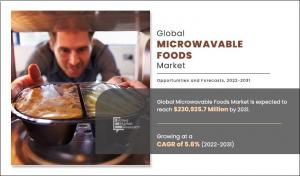Microwavable Foods Market to Receive Overwhelming Hike In Revenue That Will Boost Overall Industry Growth by 2031
Rise in popularity of fast-food restaurants and large population base coupled with increase in number of quick-service restaurants drive the global market.
WILMINGTON, DE, UNITED STATES, July 15, 2025 /EINPresswire.com/ -- Microwavable Foods Market Size size was accounted for $120.45 billion in 2020, and is expected to reach $230.93 billion by 2031, growing at a CAGR of 5.6% from 2022 to 2031.The growing popularity of fast-food restaurants, along with a large and expanding population base and the increasing number of quick-service restaurants, is driving the growth of the global microwaveable foods market. However, limited consumer awareness about microwaveable food products poses a challenge to market expansion. On the other hand, rising disposable incomes and accelerating urbanization are expected to create promising opportunities for market growth in the coming years.
Download Sample Report @ https://www.alliedmarketresearch.com/request-sample/3492
The microwavable foods market presents significant opportunities for manufacturers, driven by the growing consumer preference for frozen meals. The increasing popularity of microwavable foods among millennials has further propelled market growth, as this demographic shows a strong inclination toward convenient, healthy, and nutritious food options. The rising demand is also fueled by consumers’ busy and fast-paced lifestyles, which have increased the reliance on quick and easy meal solutions worldwide. In response, key industry players are pursuing strategies such as mergers, acquisitions, and new product launches to strengthen their market presence and remain competitive in the evolving microwavable foods landscape.
The growing demand for convenient microwavable food products that align with modern lifestyles being healthy, ethical, and comforting is a prominent trend across the U.S. and European nations, including the UK, Germany, and France. In developed countries, increased adoption of household cooking technologies has further propelled market growth. Additionally, rising disposable incomes in emerging economies like China, India, and Brazil have led consumers to spend more on time- and labor-saving food options. With less willingness to invest time in meal preparation, many consumers prioritize convenience over cost. As a result, they increasingly opt for shelf-stable, chilled, and frozen microwavable foods over traditional home-cooked meals. The shift in household dynamics particularly the rise in dual-income families and more women participating in the workforce also contributes to the growing demand for quick and easy meal solutions, further boosting the microwavable foods market.
Buy This Research Report: https://www.alliedmarketresearch.com/microwavable-foods-market/purchase-options
The microwavable foods industry has witnessed a significant growth rate, owing to increased consumption of microwavable ready meals across the globe. Rapid urbanization and fast-paced lifestyle have shifted the preferences of consumers toward use of microwavable food products, which require less time for cooking than traditional home cooked meal. Moreover, advancement in freezing technology has led to the emergence of frozen microwavable foods, which contributes extensively toward the growth of market.
By region, the market across Europe, followed by North America, dominated in 2020, accounting for more than one-third of the market, owing to high consumption of microwavable foods. However, the market across Asia-Pacific is anticipated to showcase the highest CAGR of 7.2% during the forecast period, owing to rise in the number of working women population.
For Purchase Enquiry @ https://www.alliedmarketresearch.com/purchase-enquiry/3492
Major market players
Ajinomoto Windsor, Inc.
ConAgra Foods, Inc.
Campbell Soup Company
Kellogg Company
General Mills Inc.
Nestle SA
McCain Foods
Pinnacle Food Inc.
Unilever Plc.
The Kraft Heinz Company
Similar Reports:
Citric Acid Regulators Market: https://www.alliedmarketresearch.com/citric-acid-regulators-market-A18664
Cream Powder Market: https://www.alliedmarketresearch.com/cream-powder-market-A39197
Coconut Shell Powder Market: https://www.alliedmarketresearch.com/coconut-shell-powder-market-A31634
David Correa
Allied Market Research
+ +1 800-792-5285
email us here
Visit us on social media:
LinkedIn
Facebook
YouTube
X
Legal Disclaimer:
EIN Presswire provides this news content "as is" without warranty of any kind. We do not accept any responsibility or liability for the accuracy, content, images, videos, licenses, completeness, legality, or reliability of the information contained in this article. If you have any complaints or copyright issues related to this article, kindly contact the author above.
Machine Control System Market Expected to Hit $12.2 Billion by 2032, Exhibiting 10.6% CAGR
Doula Doc & Me Launches Statewide Initiative to Reduce Maternal Health Disparities in Underserved Communities
Lydia M. Hawke Casts a Spell and Secures Her Spot as a Must-Read Author for the Next Generation
Więcej ważnych informacji
 Jedynka Newserii
Jedynka Newserii

 Jedynka Newserii
Jedynka Newserii

Problemy społeczne

Sukces gospodarczy Polski może zachęcić do powrotów Polaków mieszkających za granicą. Nowa rządowa strategia ma w tym pomóc
Polska coraz mocniej stawia na powroty swoich obywateli z zagranicy. Rządowa strategia współpracy z Polonią na najbliższe lata zakłada system zachęt dla osób powracających, ale też ułatwienia w uznawaniu wykształcenia i kwalifikacji, podejmowaniu studiów czy staży zawodowych. To w obliczu rosnących wyzwań demograficznych i zapotrzebowania na wysoko wykwalifikowaną kadrę szansa na wzmocnienie rynku pracy. Napływ wykwalifikowanych specjalistów z doświadczeniem zdobytym za granicą może pomóc w modernizacji krajowej gospodarki.
Prawo
ZPP: Działania administracji narażają na szwank wysiłek deregulacyjny. Niektóre niosą znamiona dyskryminacji i nękania przedsiębiorców

Choć rząd zgodnie z zapowiedziami realizuje szeroko zakrojone zmiany deregulacyjne, przedsiębiorcy alarmują, że brakuje w nich spójności, przewidywalności i realnej poprawy, zwłaszcza w kontaktach z administracją. Jako przykład ZPP podaje przypadek firmy British American Tobacco (BAT) i jej zatrzymanego przez izbę celno-skarbową zamówienia 200 tys. kartridży do e-papierosów. Dotknięte tą decyzją spółki liczą straty.
Konsument
Branża piwowarska dodaje do polskiej gospodarki ponad 20,5 mld zł rocznie. Spadki sprzedaży i produkcji piwa uderzają również w inne sektory

Branża piwowarska pozostaje ważnym ogniwem polskiej gospodarki. Nowy raport CASE wskazuje, że generuje ona 3 proc. dochodów budżetowych i 85 tys. miejsc pracy w samych browarach i innych powiązanych sektorach. Dlatego kurczący się rynek piwa może mieć poważne reperkusje – już dziś nadwyżka mocy produkcyjnych przekracza 10 mln hl. Spadki są spowodowane m.in. znaczącym wzrostem kosztów działalności, spadkiem konsumpcji, a także uderzającymi w browarników zmianami regulacyjnymi.
Partner serwisu
Szkolenia

Akademia Newserii
Akademia Newserii to projekt, w ramach którego najlepsi polscy dziennikarze biznesowi, giełdowi oraz lifestylowi, a także szkoleniowcy z wieloletnim doświadczeniem dzielą się swoją wiedzą nt. pracy z mediami.









.gif)



